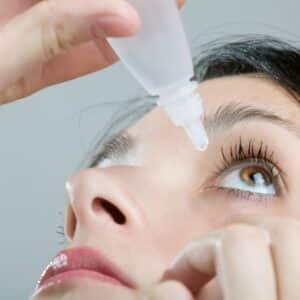UV Radiation and Eye Damage
Ultraviolet (UV) radiation is electromagnetic radiation emitted by the sun and some artificial sources, such as tanning beds and welding machines. UV radiation is invisible to the human eye and is divided into three categories: UVA, UVB, and UVC. UVC radiation is absorbed by the Earth’s atmosphere and does not threaten humans, but UVA and UVB radiation can cause damage to the skin and eyes.
Exposure to UV radiation can lead to various eye conditions, including photokeratitis, pterygium, and cataracts. Photokeratitis is a painful condition that affects the cornea and can cause symptoms such as redness, tearing, and sensitivity to light. Pterygium is a growth on the eye’s surface that can cause vision problems if it grows over the cornea. Cataracts are a clouding of the eye’s lens that can lead to vision loss if left untreated.
The damage caused by UV radiation is cumulative, which means it builds up over time. This makes it especially important to protect your eyes from UV radiation starting at a young age. Children are particularly vulnerable to UV radiation because their eyes are still developing, and they spend more time outdoors than adults.
How Can the Sun Damage Your Eyes?
The sun emits harmful ultraviolet (UV) rays, which can cause damage to different parts of the eye. When the eyes are exposed to excessive amounts of UV radiation, it can lead to a range of problems, including:
- Corneal sunburn: Also known as photokeratitis, this is a painful condition that occurs when the cornea, the clear outer layer of the eye, is exposed to excessive UV radiation. It can cause temporary vision loss, redness, swelling, and a gritty eye sensation.
- Cataracts: Cataracts are a clouding of the eye’s natural lens, which can cause blurry vision, glare, and halos around lights. Exposure to UV radiation can speed up the development of cataracts, especially in people who spend a lot of time in the sun without protection.
- Macular degeneration: Macular degeneration is a condition that causes the retina’s center to deteriorate, leading to a loss of central vision. Studies have shown that exposure to UV radiation can increase the risk of developing macular degeneration.
- Pterygium: Pterygium is a tissue growth that can develop on the white of the eye, usually on the side closest to the nose. It can cause redness, irritation, and a feeling like something is in the eye. Pterygium is often caused by excessive UV exposure.
- Skin cancer: The skin around the eyes is very thin and delicate, making it more susceptible to sun damage and skin cancer. The most common type of skin cancer around the eyes is basal cell carcinoma, which can cause a raised, pearly bump or a scaly patch on the eyelid.
Protecting your eyes from the sun’s harmful UV rays is vital to avoid these severe eye conditions.
How to Prevent Sun Eye Damage?
Our eyes are an essential part of our body, and taking care of them is crucial. One of the most significant risks to our eyes is sun damage. Prolonged exposure to the sun’s UV radiation can cause several eye conditions, including cataracts, macular degeneration, and cancer. The good news is that there are several ways to protect your eyes from sun damage. Here are some tips to help you do just that:
- Wear sunglasses: The most effective way to protect your eyes from UV radiation is to wear sunglasses. Not all sunglasses offer the same level of protection, so make sure you choose sunglasses that block 100% of both UVA and UVB rays. Look for sunglasses with a UV 400 rating, which provides maximum protection from the sun’s harmful rays.
- Wear a hat: In addition to sunglasses, wearing a hat with a brim can also help protect your eyes from the sun. A hat can provide shade for your eyes, reducing the amount of UV radiation that reaches them.
- Use sunscreen: While it is not specifically designed for your eyes, it can still help protect them from sun damage. Applying sunscreen around your eyes and eyelids can help reduce the risk of skin cancer and other eye conditions caused by sun damage.
- Limit exposure during peak hours: The sun’s rays are strongest between 10 a.m. and 2 p.m. Try to limit your exposure to the sun during these hours. If you must be outside, wear sunglasses and a hat to protect your eyes.
- Take breaks: If you’re spending a lot of time outside, take frequent breaks to rest your eyes. You can also give your eyes a break by going inside or finding a shady spot to relax.
- Get regular eye exams: Regular eye exams are essential to maintaining healthy eyes. During your exam, your eye doctor can check for any signs of sun damage and recommend how to protect your eyes in the future.
Protecting your eyes from sun damage is essential for maintaining healthy eyes. Wearing sunglasses, hats, and sunscreen can help reduce the risk of eye conditions caused by UV radiation. By taking these simple steps, you can help ensure that your eyes stay healthy and happy for years.
Can Your Eyes Heal From Sun Eye Damage?
The extent to which sun-damaged eyes can heal depends on the severity of the damage. While the body can repair minor eye damage caused by UV radiation, more severe damage may be irreversible.
Mild sun damage to the eyes, such as temporary blindness, blurred vision, or eye irritation, may heal within a few days to weeks. However, repeated exposure to UV radiation without protection can lead to long-term eye damage, such as cataracts, macular degeneration, and even permanent vision loss.
In some cases, treatment options like surgery, medication, or vision aids may be available to help manage the damage caused by UV radiation. However, it’s important to remember that prevention is the best way to protect your eyes from sun damage. By wearing proper UV-blocking sunglasses and a hat and avoiding prolonged exposure to the sun, you can reduce your risk of sun-related eye damage.
Is it Ever Safe to Stare at The Sun?
No, it is never safe to stare directly at the sun. The sun emits harmful ultraviolet (UV) radiation that can damage your eyes. When you stare directly at the sun, the intense UV radiation can cause a condition called solar retinopathy, which damages the retina at the back of your eye. This can lead to permanent vision loss, distortion, and even blindness.
Even if clouds or the horizon partially obscures the sun, it is still dangerous to look at it directly. The UV radiation can pass through clouds or be reflected off surfaces, such as water or snow, and still cause damage to your eyes.
It is also important to note that using homemade filters or non-specialized glasses, such as sunglasses, binoculars, or telescopes, is not a safe way to look at the sun. These methods do not provide sufficient protection against harmful UV radiation.
Suppose you want to safely view a solar eclipse or other astronomical event involving the sun. In that case, it is recommended to use specialized equipment designed for this purpose, such as solar filters or eclipse glasses. These products are designed to block out harmful UV radiation and allow you to view the event safely.
Conclusion
Protecting your eyes from the harmful effects of the sun is crucial for maintaining good eye health. Sun-related eye conditions such as cataracts, macular degeneration, and pterygium can seriously affect your vision and overall quality of life.
If you experience any symptoms of sun-related eye conditions, such as blurry vision, eye pain, or sensitivity to light, seek medical attention immediately. To prevent these conditions, wearing sunglasses with proper UV protection, a hat or visor, and avoiding staring directly at the sun is essential. Remember to prioritize your eye health by practicing safe sun habits and regular visits to your eye doctor.






